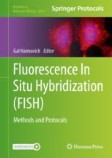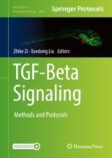Search
Search Results
-
Fluorescent In Situ Detection of RNA–Protein Interactions in Intact Cells by RNA-PLA
RNA–protein proximity ligation assay (RNA-PLA) enables the detection of specific RNA–protein interactions in fixed cells. In RNA-PLA, bridging and...
-
Analyzing Fcγ-Receptor Interactions on Monocytes with the Proximity Ligation Assay (PLA)
Proximity ligation assays (PLA) enable the detection and characterization of protein interactions independent of protein abundance or genetic...
-
Map** In Situ RNA–RNA Interactions with RIC-seq
Mammalian genomes encode large amounts of noncoding RNAs (ncRNAs), which tend to form intricate structures and interact with their target RNA...
-
Single-Molecule Fluorescent In Situ Hybridization (smFISH) for RNA Detection in Bacteria
In this chapter, we describe in detail how to perform a successful smFISH experiment and how to quantify mRNA transcripts in bacterial cells. The...
-
Using a Modified Proximity Ligation Protocol to Study the Interaction Between Chaperones and Associated Proteins
Molecular chaperones can interact with multiple proteins to form large networks. Understanding these interactions may shed light on the complexity of...
-
Profiling of RNA-binding protein binding sites by in situ reverse transcription-based sequencing
RNA-binding proteins (RBPs) regulate diverse cellular processes by dynamically interacting with RNA targets. However, effective methods to capture...

-
ClampFISH 2.0 enables rapid, scalable amplified RNA detection in situ
RNA labeling in situ has enormous potential to visualize transcripts and quantify their levels in single cells, but it remains challenging to produce...

-

-
Light-Seq: light-directed in situ barcoding of biomolecules in fixed cells and tissues for spatially indexed sequencing
We present Light-Seq, an approach for multiplexed spatial indexing of intact biological samples using light-directed DNA barcoding in fixed cells and...

-
Laser Targeted Oligo Ligation (LTOL) to Identify DNA Sequences in the Vicinity of a Single Subnuclear Structure in a Single Cell
Gene loci are organized around nuclear substructures, forming gene hubs which provide a level of transcriptional control. To date, most techniques...
-
Proximity ligation assay: an ultrasensitive method for protein quantification and its applications in pathogen detection
AbstractIt is of great significance to establish sensitive and accurate pathogen detection methods, considering the continuous emergence or...

-
Transcriptome analysis of gene expression profiling from the deep sea in situ to the laboratory for the cold seep mussel Gigantidas haimaensis
BackgroundThe deep-sea mussel Gigantidas haimaensis is a representative species from the Haima cold seep ecosystem in the South China Sea that...

-
Puromycin Labeling Coupled with Proximity Ligation Assays to Define Sites of mRNA Translation in Drosophila Embryos and Human Cells
Genetic mutations, whether they occur within protein-coding or noncoding regions of the genome, can affect various aspects of gene expression by...
-
Global in situ profiling of RNA-RNA spatial interactions with RIC-seq
Emerging evidence has demonstrated that RNA-RNA interactions are vital in controlling diverse biological processes, including transcription, RNA...

-
Multiplex DNA fluorescence in situ hybridization to analyze maternal vs. paternal C. elegans chromosomes
Recent advances in microscopy have enabled studying chromosome organization at the single-molecule level, yet little is known about inherited...

-
Preparation of long single-strand DNA concatemers for high-level fluorescence in situ hybridization
Fluorescence in situ hybridization (FISH) is a powerful tool to visualize transcripts in fixed cells and tissues. Despite the recent advances in FISH...

-
Branched Proximity Hybridization Assay for the Quantification of Nanoscale Protein–Protein Proximity
To better quantify the nanoscale protein–protein proximity, we developed a new branched proximity hybridization assay (bPHA). In this assay,...
-
Single-Cell Joint Profiling of Open Chromatin and Transcriptome by Paired-Seq
Simultaneous detection of chromatin accessibility and transcription from the same cells promises to greatly facilitate the dissection of...
-
DNA Damage In Situ Ligation Followed by Proximity Ligation Assay (DI-PLA)
Cells have evolved DNA repair mechanisms to maintain their genetic information unaltered and a DNA damage response pathway that coordinates DNA...
-
piggyBac-mediated genomic integration of linear dsDNA-based library for deep mutational scanning in mammalian cells
Deep mutational scanning (DMS) makes it possible to perform massively parallel quantification of the relationship between genetic variants and...

